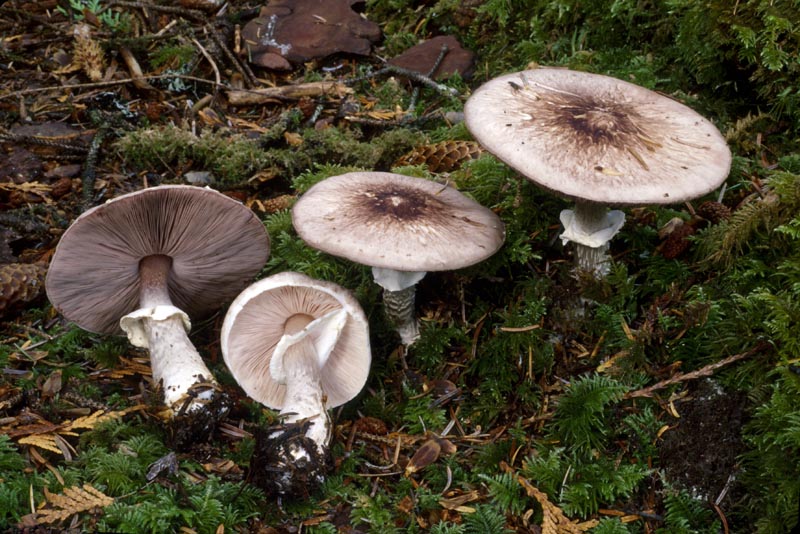
© Steve Trudell
Danny’s DNA Discoveries – Agaricus of the PNW
by Danny Miller
|
|
Danny’s DNA Discoveries – Agaricus of the PNW
|
|
Introduction
Agaricus are easily recognized by dark chocolate brown spores and free gills. As a bonus, they always have a partial veil that usually leaves a ring on the stem. Their stature is usually large (most reach 10 cm across, often 20 cm) although there is one group that usually stay 5 cm or less. Some are squat and stocky, with thick stems that are not much longer than the cap width. The caps are always dry and often fibrillose or scaly. The spores may turn pink before they turn dark chocolate and leave the gills, so a young specimen may have pink gills, but a spore print will always be dark chocolate. You can tell the subgenera apart by size, staining reaction (fast red, slow red, yellow or none) and odor (sweet almond, creosote or none). You may have to cut one in half and wait several minutes to see the staining reaction, which may only happen in certain places. Interestingly, this is the only group of mushrooms I know where the poisonous ones might smell or taste bad and the edible ones might smell or taste good. Except for Agaricus, that is never the case. The sweet odor and taste of some species is an interesting contrast to the usual savory flavours of mushrooms. Agaricus campestris was the first gilled mushroom ever named, back in 1753. Therefore, every gilled mushroom in the world used to be called Agaricus until they realized that was going to be too many for a single genus. Agaricus of North America by Rick Kerrigan is essential if you want to ID your Agaricus, as it contains the only modern comprehensive key. abundant common uncommon rare - colour codes match my Pictorial Key and are my opinions and probably reflect my bias of living in W WA. Rare species may be locally common in certain places at certain times. |
|
Summary of Interesting Results
Here are some of the newest, most interesting results of the study:
|
 Agaricus section Minores - click to expand Agaricus section Minores - click to expand
The smallest ones, often <5 cm. All these species stain yellow (perhaps orange), often with the colour strengthening over time. They have a sweet almond scent. KOH reaction yellow. Species mentioned: Agaricus comtulus, micromegathus, kerriganii, semotus, diminutivus, purpurellus, dulcidulus, jacobi, comptuloides, friesianus |
 Agaricus section Arvenses - click to expand Agaricus section Arvenses - click to expand
Larger, typically at least 10 cm at maturity (and up to 20 cm or more), but otherwise similar to section Minores: they also may stain yellow (perhaps orange) usually slowly, sometimes not at all at first, but similarly, the colour will strengthen over time. They always with a sweet almond scent that can be teased out of them at least if the flesh is crushed. KOH reaction yellow. Species mentioned: Agaricus augustus, smithii, smithianus, subrufescens, arvensis, nivescens, osecanus, parkensis, fissuratus, coepiochraceus, crocodilinus, excellens, albolutescens, moronii, summensis, albiceps, sylvicola, macrocarpus, abruptibulbus, mesocarpus, gemellatus, didymus, sandianus |
 Agaricus section Xanthodermati - click to expand Agaricus section Xanthodermati - click to expand
These species stain yellow to orange (quickly or slowly) with the colour fading in time, and have a creosote/phenolic odor (unpleasant like science lab chemicals). You may have to crush the stem base flesh to detect the odor. Also try sniffing where the gills meet the stem. KOH reaction yellow. These species are poisonous. Species mentioned: Agaricus xanthodermus, buckmacadooi, deardorffensis, moelleri, praeclarasquamosus, hondensis, subrufescentoides, cervinifolius, californicus |
 Agaricus section Sanguinolenti - click to expand Agaricus section Sanguinolenti - click to expand
Strong and/or quick red staining reaction. Normal mushroom odor. No KOH reaction. The one strong red stainer that doesn't belong here smells briny and is very squat (stem shorter than the cap width and almost as wide). These species are not well known yet in the PNW, and much is left to learn. Save any that you find. Species mentioned: Agaricus thujae, haemorrhoidarius, sylvaticus subsp occidentalis, albosanguineus, benesii, bivelatoides |
 Agaricus section Chitonioides - click to expand Agaricus section Chitonioides - click to expand
A quick or strong red staining reaction, stem almost as thick as the cap is wide and very short (very squat mushroom) that grows in salty areas and smells briny itself. Inrolled cap margin. KOH negative. Species mentioned: Agaricus bernardii |
 Agaricus section Bivelares - click to expand Agaricus section Bivelares - click to expand
A slow red reaction (if at all). Normal mushroom odor. The ring sometimes sheathes upwards and then outwards instead of down and out, but is always well developed (unlike the similar section Agaricus) and they usually grow in compost or disturbed areas, not deep in forests (unlike the similar /Subrutilescentes). KOH negative. Species mentioned: Agaricus bitorquis, bisporus |
 Agaricus section Subrutilescentes
- click to expand Agaricus section Subrutilescentes
- click to expand
No staining reaction. Normal mushroom odor. KOH green. Well developed ring. Found deep in forests under conifers with dark vinaceous brown scaly caps. Species mentioned: Agaricus subrutilescens, thiersii |
 Agaricus section Agaricus
- click to expand Agaricus section Agaricus
- click to expand
No staining reaction (rarely slightly orange). Normal mushroom odor. KOH negative. The stem often tapers and the veil leaves tissue hanging off the edge of the cap but not much of a ring compared to the other subgenera. Usually found in grass. Species mentioned: Agaricus campestris, porphyrocephalus, porphyrocephalus var pallidus, braendlei, argenteus, aristocratus, altipes, chionodermus |
 Secotioid and Little Known Agaricus - click to expand Secotioid and Little Known Agaricus - click to expandSpecies mentioned: Agaricus deserticola, inapertus, zelleri. Secotium texense. Longula texensis. Endoptychum depressum. Gyrophragmium. Agaricus cervinifolius, chionodermus, flavitingens, lilaceps, coepiochraceus, crassistipus, crocodilinus var mutabilis, fugaciovelus, gracilifolius, helodes, hotsonii, integer, involucratus, lamellodistans, subsolidipes, tennuiannulatus, brevistipes, elwhaensis |
Summary of Future Studies Needed